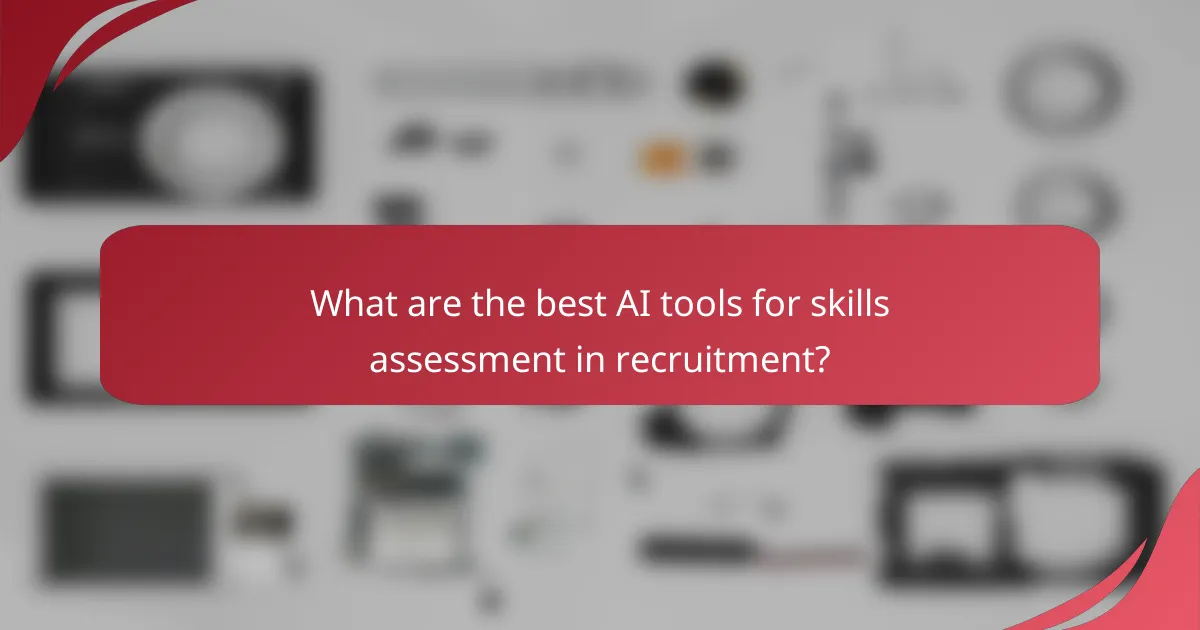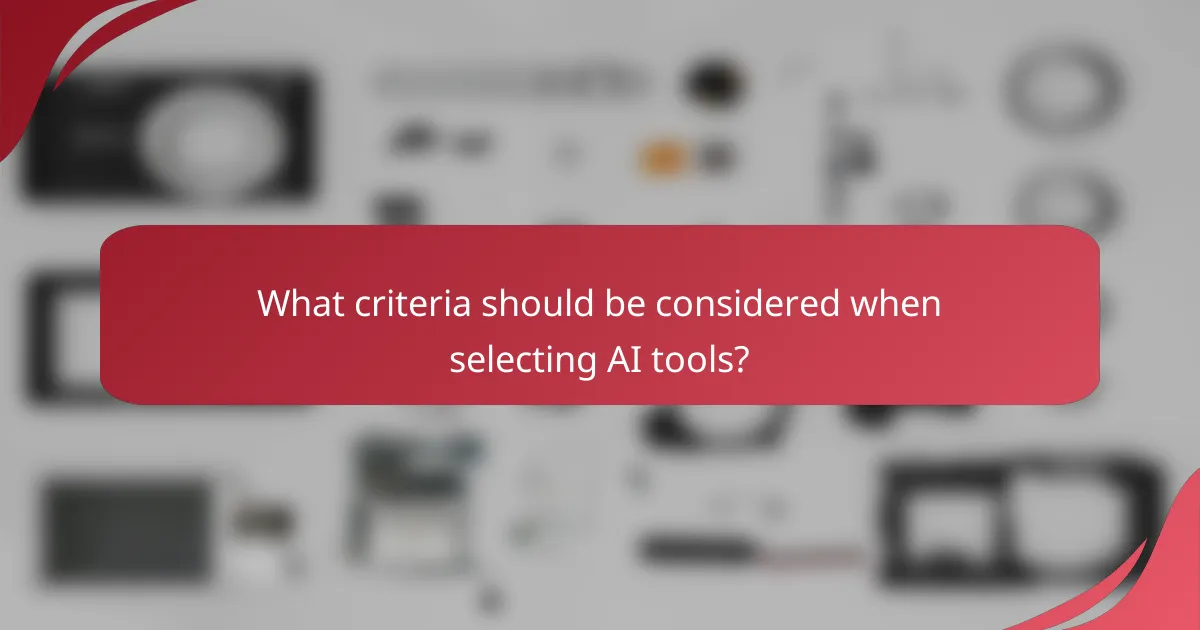AI for skills assessment in recruitment revolutionizes the hiring process by utilizing advanced methodologies to evaluate candidates’ abilities accurately. By incorporating tools such as video interviews, gamified assessments, and coding challenges, recruiters can streamline evaluations and enhance candidate matching. This data-driven approach not only reduces human error but also ensures a more efficient identification of the best-fit candidates for each role.

What are the best AI tools for skills assessment in recruitment?
The best AI tools for skills assessment in recruitment streamline the evaluation process, enhance candidate matching, and provide data-driven insights. These tools utilize various methodologies, including video interviews, gamified assessments, and coding challenges to gauge candidates’ abilities effectively.
HireVue
HireVue combines video interviewing with AI-driven analysis to assess candidates’ skills and fit for a role. The platform evaluates verbal and non-verbal cues during interviews, providing insights into a candidate’s communication abilities and personality traits.
Employers can customize assessments based on specific job requirements, making it easier to identify top candidates. However, it’s essential to ensure that the AI algorithms are regularly updated to avoid bias and maintain fairness in evaluations.
Pymetrics
Pymetrics uses neuroscience-based games to evaluate candidates’ cognitive and emotional traits. The platform assesses various skills, such as problem-solving and teamwork, through engaging tasks that simulate real-world scenarios.
This tool is particularly useful for companies looking to enhance diversity and inclusion in hiring, as it focuses on potential rather than traditional qualifications. Organizations should consider integrating Pymetrics into their recruitment process to gain a more holistic view of candidates.
Codility
Codility specializes in technical assessments for software engineering roles, allowing recruiters to evaluate coding skills through real-time challenges. Candidates can complete tasks in various programming languages, providing a clear picture of their technical abilities.
Employers can use Codility to create tailored tests that reflect the specific skills needed for a position. It’s crucial to ensure that the assessments are relevant to the job to avoid discouraging potential talent.
HackerRank
HackerRank offers a platform for coding assessments and technical interviews, enabling companies to evaluate developers’ skills through coding challenges and competitions. The tool supports a wide range of programming languages and allows for customizable assessments.
Recruiters should leverage HackerRank’s analytics to identify strong candidates based on their performance metrics. Regularly updating the challenge library can help keep the assessments relevant to current industry standards.
LinkedIn Talent Insights
LinkedIn Talent Insights provides data-driven insights into talent pools and skills trends, helping recruiters make informed hiring decisions. The tool analyzes LinkedIn’s vast network to identify skill gaps and emerging trends in the job market.
Using this tool, organizations can benchmark their hiring strategies against industry standards and adjust their recruitment efforts accordingly. It’s beneficial to regularly review the insights to stay ahead in attracting top talent.

How does AI improve skills assessment in recruitment?
AI enhances skills assessment in recruitment by providing accurate evaluations of candidates’ abilities through data analysis and automated tools. This technology streamlines the hiring process, reduces human error, and helps identify the best-fit candidates more efficiently.
Data-driven insights
AI utilizes large datasets to generate insights about candidates’ skills and potential performance. By analyzing past hiring data, job performance metrics, and skill assessments, AI can identify patterns that human recruiters might overlook. This leads to more informed hiring decisions based on objective criteria rather than subjective impressions.
For example, AI tools can evaluate coding skills through online assessments, comparing results against a database of successful candidates. This method allows recruiters to pinpoint candidates who possess the specific skills required for a role, increasing the likelihood of successful hires.
Bias reduction
AI can help reduce biases in the recruitment process by standardizing evaluations and focusing on skills rather than demographic factors. By using algorithms that prioritize objective data, organizations can minimize the influence of unconscious biases that often affect hiring decisions.
However, it is crucial to ensure that the AI systems themselves are free from biases in their training data. Regular audits and updates to the algorithms can help maintain fairness and equality in candidate assessments, aligning with best practices in diversity and inclusion.
Enhanced candidate experience
AI improves the candidate experience by streamlining the application process and providing timely feedback. Automated systems can quickly assess applications and inform candidates of their status, reducing the waiting time that often frustrates job seekers.
Moreover, AI-driven chatbots can answer candidate queries in real-time, offering support and guidance throughout the recruitment journey. This level of engagement not only enhances the candidate experience but also reflects positively on the employer’s brand, making it more attractive to top talent.

What methods are used in AI skills assessment?
AI skills assessment employs various methods to evaluate candidates’ abilities effectively. These methods leverage data-driven insights to enhance recruitment processes and ensure a better match between candidates and job requirements.
Predictive analytics
Predictive analytics uses historical data to forecast future performance and skills fit. By analyzing past hiring data, organizations can identify patterns that indicate successful candidates, allowing recruiters to make informed decisions based on predictive models.
For effective implementation, companies should ensure they have a robust dataset that includes diverse candidate profiles. This helps avoid biases and enhances the accuracy of predictions, leading to better hiring outcomes.
Natural language processing
Natural language processing (NLP) analyzes candidates’ written or spoken communication to assess their language skills and comprehension. This method can evaluate resumes, cover letters, and interview responses to gauge the suitability of candidates for specific roles.
Employers can utilize NLP tools to automate the screening process, saving time and resources. However, it is crucial to ensure that the algorithms are trained on diverse language inputs to minimize bias and improve fairness in assessments.
Gamification techniques
Gamification techniques incorporate game-like elements into skills assessments to engage candidates and evaluate their abilities in a dynamic environment. These methods can include simulations, challenges, and interactive tasks that reflect real job scenarios.
When implementing gamification, it is essential to design tasks that align closely with job responsibilities. This approach not only makes assessments more enjoyable but also provides insights into candidates’ problem-solving skills and adaptability under pressure.

What are the best practices for implementing AI in recruitment?
Implementing AI in recruitment requires a strategic approach to ensure effectiveness and compliance. Best practices include defining clear objectives, ensuring data privacy compliance, and integrating AI tools with existing systems.
Define clear objectives
Establishing clear objectives is crucial for the successful implementation of AI in recruitment. Identify specific goals such as improving candidate screening efficiency, enhancing diversity, or reducing time-to-hire. This clarity helps in selecting the right AI tools and measuring their effectiveness.
Consider setting measurable targets, such as aiming for a 20-30% reduction in screening time or increasing the diversity of shortlisted candidates by a specific percentage. Regularly review these objectives to adapt to changing recruitment needs.
Ensure data privacy compliance
Data privacy compliance is essential when using AI in recruitment, especially with regulations like GDPR in Europe or CCPA in California. Ensure that candidate data is collected, stored, and processed in accordance with relevant laws to avoid legal repercussions.
Implement measures such as anonymizing candidate data and obtaining explicit consent before data collection. Regular audits and training for staff on data privacy practices can further safeguard compliance and build trust with candidates.
Integrate with existing systems
Integrating AI tools with existing recruitment systems enhances efficiency and data flow. Ensure that the AI solutions you choose can seamlessly connect with your applicant tracking system (ATS) or human resource management system (HRMS) to streamline processes.
Consider conducting a compatibility assessment before implementation. This may involve checking API availability or data format compatibility. Proper integration minimizes disruptions and maximizes the benefits of AI in recruitment.

What criteria should be considered when selecting AI tools?
When selecting AI tools for skills assessment in recruitment, consider factors such as accuracy, ease of integration, scalability, and compliance with data protection regulations. These criteria ensure that the tools effectively evaluate candidates while aligning with organizational needs and legal standards.
Accuracy and Reliability
Accuracy is crucial when choosing AI tools, as they must reliably assess candidates’ skills. Look for tools that utilize validated algorithms and have a proven track record in similar recruitment contexts. Conducting pilot tests can help gauge their effectiveness before full implementation.
Integration with Existing Systems
AI tools should seamlessly integrate with your current recruitment systems, such as applicant tracking systems (ATS) or human resource management software (HRMS). Ensure that the tools support common data formats and APIs to facilitate smooth data transfer and minimize disruption during the onboarding process.
Scalability
Consider the scalability of AI tools to accommodate your organization’s growth. Tools should handle varying volumes of candidates without compromising performance. Look for solutions that offer flexible pricing models, allowing you to adjust usage as your recruitment needs change.
Compliance with Regulations
Ensure that the AI tools comply with relevant data protection regulations, such as the General Data Protection Regulation (GDPR) in Europe or the California Consumer Privacy Act (CCPA) in the United States. This compliance protects candidate data and mitigates legal risks associated with data handling and processing.
Cost-Effectiveness
Evaluate the cost-effectiveness of AI tools by comparing their pricing structures against the benefits they provide. Consider both upfront costs and ongoing expenses, such as subscription fees or maintenance costs. Aim for tools that offer a good balance between price and functionality, ensuring a strong return on investment.


